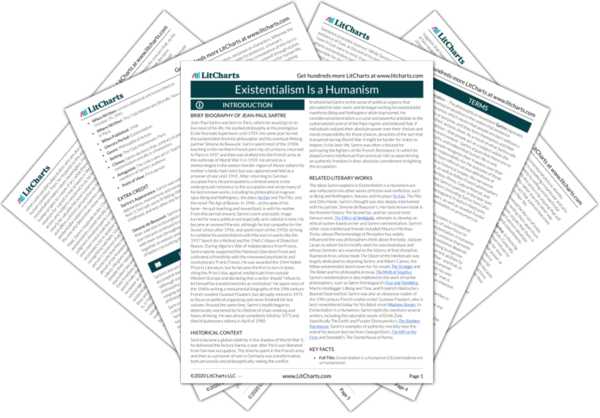Welcome to the LitCharts study guide on Jean-Paul Sartre's Existentialism Is a Humanism. Created by the original team behind SparkNotes, LitCharts are the world's best literature guides.
Existentialism Is a Humanism: Introduction
Existentialism Is a Humanism: Plot Summary
Existentialism Is a Humanism: Detailed Summary & Analysis
Existentialism Is a Humanism: Themes
Existentialism Is a Humanism: Quotes
Existentialism Is a Humanism: Characters
Existentialism Is a Humanism: Terms
Existentialism Is a Humanism: Symbols
Existentialism Is a Humanism: Theme Wheel
Brief Biography of Jean-Paul Sartre

Historical Context of Existentialism Is a Humanism
Other Books Related to Existentialism Is a Humanism
Key Facts about Existentialism Is a Humanism
- Full Title: Existentialism Is a Humanism (L’Existentialisme est un humanisme)
- When Written: Lecture delivered and transcribed on October 29, 1945
- Where Written: The Club Maintenant [literally “Now Club”] in Paris
- When Published: 1946
- Literary Period: Existentialism
- Genre: Philosophical lecture
- Setting: The Club Maintenant, Paris
- Climax: Sartre declares that, contrary to popular belief, existentialism actually is a humanism.
- Antagonist: The critics who act in “bad faith,” including members of Sartre’s audience
- Point of View: First-person
Extra Credit for Existentialism Is a Humanism
Sartre’s Appearance. Sartre was well-known for his peculiar appearance, mannerisms and sense of style. He was barely five feet (1.5m) tall, wore ill-fitting clothes, had a lazy eye from childhood, and was often the first to proclaim his own ugliness.
Simone de Beauvoir. Sartre and de Beauvoir were famous for their aversion to bourgeois relationship norms. They never married and continued to pursue other relationships in parallel with their own throughout their lives. They even worked together to seduce younger women and exchanged thousands of letters recounting their relationships.







